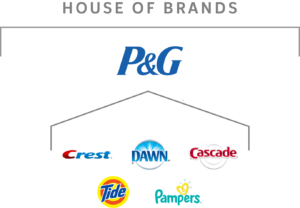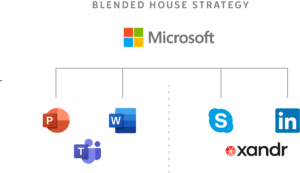At launch, companies generally take one of two paths when it comes to defining their portfolio structure.
In the more basic framework, known as a branded house, the product shares a name and ethos with the company brand creating an inherent link between the two. Over time, as new products rollout, they follow suit and share the same brand name. Apple is a classic example that demonstrates how leveraging a branded house structure can extend equity and iconic appeal while elevating consumer trust and adoption.

Alternatively, a company may choose to build a separate brand for the product to allow room for growth from the start. This structure is known as a house of brands, and it allows companies the flexibility to offer a wide variety of products that appeal to diverse audiences. P&G is a classic example of a house of brands, owning a variety of well-known consumer packaged goods each with their own name and identity like Tide, Crest and Pampers.

Many companies find success by sticking with their original structure. However, for some companies, these simpler structures do not offer enough flexibility to support growth. When this is the case, we often see companies shift to a blended house, which combines elements of both structures to create a more flexible foundation.
In a blended house, some products share the company brand while others standalone. Microsoft, which has a diverse set of offerings from Microsoft Word to Xbox, is an example of a company that grew into a blended house.

Over time, you may find yourself needing to decide if your own company’s existing structure leaves room for proper growth or if you need to evolve to something new. Below are some questions to consider as you develop or acquire brands that grow your portfolio:
Does this new product offering fit the ethos of your current brand?
Ultimately, brand is dependent on what your customer thinks and expects from you. When deciding how to brand something new, you must consider if it is in line with those expectations and will offer value to existing customers.
Who is the target customer your brand is trying to reach?
Different audiences interact with and gain value from brands in different ways. By understanding who your specific targets are and the motivations that help them make decisions, you can consider if one brand can reach multiple customers in the right way.
How much capital does your company have to invest in branding?
Creating and maintaining a new brand is a costly decision, especially in a portfolio of many. By carefully considering if you can sustain a brand (or multiple brands) overtime, you are setting yourself up for a more stable future.
_____________________________________________________________________________________________________
In the coming weeks, we will analyze how well-known companies have changed their models as they’ve grown over time, documenting the strategic considerations necessary for brands to find the right “fit” for their portfolio structure.
If you are in a time of growth, explore our strategy offerings to see how we can help you create a portfolio structure that will serve you well into the future.